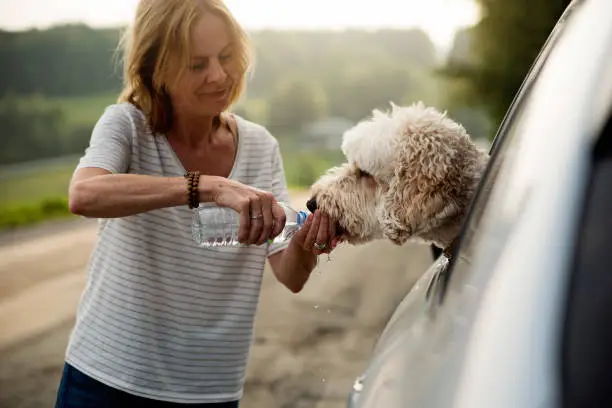Traveling with pets can be an exciting adventure, but it also comes with its own set of challenges. One of the most crucial aspects of pet care during travel is ensuring they stay hydrated. Dehydration can lead to serious health issues for pets, so it’s important to plan ahead and know how to keep your furry friend well-hydrated. In this post, we’ll cover tips and strategies for maintaining your pet’s hydration during travel.
Understanding the Importance of Hydration for Pets
Hydration is essential for all living beings, including pets. Proper hydration helps regulate body temperature, maintain healthy organ function, and ensure that your pet’s digestive system operates smoothly. During travel, pets can become stressed, which may impact their drinking habits. It’s essential to be proactive to prevent dehydration and ensure that your pet stays healthy and comfortable throughout the journey.
Pre-Travel Preparations
Before you hit the road or board a plane, it’s important to prepare for your pet’s hydration needs:
- Consult Your Vet: Before any trip, consult your veterinarian to discuss your pet’s specific needs and any travel-related concerns. Your vet can provide tailored advice based on your pet’s health, breed, and the type of travel.
- Invest in Portable Water Bowls: Purchase a portable, spill-proof water bowl or bottle designed for pets. These are available in various sizes and styles, making it easy to carry and use while on the go. Some even come with built-in water dispensers.
- Bring Extra Water Supplies: Always carry extra water for your pet. Even if you’re traveling to a place where clean water is available, having a backup ensures that your pet can stay hydrated in case of emergencies or if you find the local water is not suitable.
- Acclimate Your Pet to Travel: If your pet is not used to traveling, gradually acclimate them to the process. Short trips leading up to the main journey can help your pet adjust and reduce travel-related stress, which can affect their hydration needs.
During the Journey
Keeping your pet hydrated during the journey requires some attention and planning:
- Regular Water Breaks: Ensure that your pet has access to water at regular intervals. For car trips, plan to make stops every 2-3 hours to offer water and stretch your pet’s legs. For longer flights, inquire about the availability of pet hydration services or plan to carry sufficient water with you.
- Monitor Water Intake: Pay attention to how much water your pet is drinking. If you notice a decrease in their water intake, it could be a sign of stress or health issues. Encourage them to drink by offering water frequently and ensuring it’s fresh and clean.
- Watch for Signs of Dehydration: Familiarize yourself with the signs of dehydration, such as dry gums, lethargy, excessive panting, or sunken eyes. If you observe any of these symptoms, act quickly by providing water and seeking veterinary care if necessary.
- Avoid Giving Ice Cubes: While ice cubes might seem like a refreshing treat, they can be difficult for pets to chew and may cause discomfort, especially if your pet is stressed. Stick to plain water for hydration.
Hydration Strategies for Different Modes of Travel
Each mode of travel presents its own challenges for keeping your pet hydrated. Here’s how to handle hydration based on your mode of travel:
- Car Travel: For road trips, keep a travel kit ready with water bottles, collapsible bowls, and pet-friendly snacks. Always offer water at regular intervals and keep an eye on your pet’s behavior to ensure they are comfortable and hydrated.
- Air Travel: Air travel can be particularly challenging due to the low humidity in the cabin. Make sure to inform the airline about your pet’s needs and follow their guidelines for pet hydration. Consider using a travel bottle with a built-in bowl to make hydration easier during layovers or delays.
- Train or Bus Travel: Similar to car travel, train and bus journeys require regular water breaks. Many trains and buses are pet-friendly but check their policies beforehand to understand how you can manage your pet’s hydration needs during the trip.
Post-Travel Hydration
Once you’ve reached your destination, continue to monitor your pet’s hydration:
- Provide Fresh Water Immediately: Upon arrival, provide your pet with fresh, clean water. They may be thirsty after the journey, so ensure they have access to water at all times.
- Monitor for Any Health Issues: Keep an eye on your pet’s behavior and health in the hours following your arrival. If you notice any signs of dehydration or illness, consult a local veterinarian.
- Maintain a Hydration Routine: If you’re staying at a new location, stick to a consistent hydration routine. Ensure your pet has access to water throughout the day, especially if the climate is different from what they are used to.
Tips for Special Situations
In some cases, pets may have additional hydration needs or challenges:
- For Pets with Health Conditions: Pets with certain health conditions, such as kidney disease or diabetes, may require special hydration management. Consult your vet for specific advice and follow their recommendations closely.
- For Very Young or Old Pets: Puppies and senior pets may have different hydration needs. Be extra vigilant with these age groups and ensure they stay hydrated, as they can be more susceptible to dehydration.
- For Pets with Anxiety: Pets that experience travel anxiety may drink less. Use calming techniques and ensure their environment is as comfortable as possible to help them stay hydrated.
Conclusion
Ensuring your pet stays hydrated during travel is essential for their health and well-being. By preparing in advance, monitoring their hydration needs, and adapting to different travel scenarios, you can help your pet stay comfortable and healthy throughout the journey. Remember, a well-hydrated pet is a happy pet, and with these tips, you’ll be well-equipped to keep your furry friend hydrated no matter where your travels take you.

